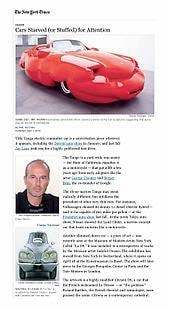
The New York Times
April 1, 2010
Cars Starved (or Stuffed) for Attention
By Phil Patton
THE Tango electric commuter car is a conversation piece wherever it appears, including the Detroit auto show in January, and last fall Jay Leno took one for a highly publicized test drive.
The Tango is a yard-wide one-seater — the State of California classifies it as a motorcycle — that got a lift a few years ago from early adopters like the actor George Clooney and Sergey Brin, the co-founder of Google.
The oh-so-narrow Tango may seem radically different, but it follows the precedent of other very thin cars. For instance, Volkswagen showed its skinny L1 diesel-electric hybrid — said to be capable of 160 miles per gallon — at the Frankfurt auto show last fall. At the 2009 Tokyo auto show, Nissan showed the Land Glider, a narrow concept car that leans on turns like a motorcycle.
Another slimmed-down car — a piece of art — was recently seen at the Museum of Modern Art in New York. Called "La DS," it was included in a retrospective of works by the Mexican artist Gabriel Orozco. The exhibition has moved from New York to Switzerland, where it opens on April 18 at the Kunstmuseum in Basel. The show will later move to the Georges Pompidou Center in Paris and the Tate Modern in London.
The artwork is a highly modified Citroën DS, a car that the French nicknamed La Déesse — or "the goddess." Roland Barthes, the French theorist and semiologist, once praised the iconic Citroën as a contemporary cathedral.
In 1993, Mr. Orozco took a silver DS, removed the engine and sliced two feet out of the middle. The result is a "car" not quite 45 inches wide. (The VW L1's width is 49 inches, the Land Glider's 43 and the Tango's just 39.)
The Citroën DS is a symbol of national pride in France, and Mr. Orozco's manipulation of it is a commentary — a bit of wry blasphemy against the goddess, like pasting a mustache on the Statue of Liberty. Like the Tango, "La DS" is so skinny it seems to trick the eye.
A news release for the MoMA show said Mr. Orozco "deliberately blurs the boundaries between the art object and the everyday environment." He had previously said that in making the piece his idea was "to deconstruct a cultural icon that is not just an icon, because it is also a machine that has a function, and to remake it on its own logic."
While thin is in, for automobiles as well as fashion models, an Austrian artist seems to demonstrate that cars are so full of themselves that they are about to burst out of their skins.
The artist, Erwin Wurm, made his Fat Cars as puffy, obese, life-size sculptures that bulge like overfilled sacks. Like the thin cars, they undercut the iconic qualities of certain cars — to transform a svelte Porsche into a pudgy roadster, as he has done, is a joke in itself.
The Fat Cars seem to poke fun at pomposity. Mr. Wurm has also done Fat Houses, mocking oversize homes. In 2002, he persuaded curators to put pillows inside their clothing and walk about art galleries — literally making fun of stuffed shirts.
Born in 1954, Mr. Wurm has a history of unusual artworks. His One Minute Sculptures was a bit of performance art created by museum visitors who agreed to serve as models for 60 seconds.
The Fat Cars have been shown around the world, including stops in Moscow, San Francisco and the Rose Art Museum at Brandeis University in Waltham, Mass.
Mr. Wurm exhibits at the Aurel Scheibler gallery in Berlin, the Galerie Krinzinger in Vienna and the Lehmann Maupin Gallery in New York, where a Wurm show is planned for the fall.
For his first Fat Car, Mr. Wurm worked with Opel designers, but found the result less than satisfactory. He told an interviewer in Austria, Peter Zuspan, that his idea was to combine something like a biological system with a mechanical one. But Opel's computerized design equipment could not produce the kind of "natural" rounded shapes that he wanted, he said. Instead, Mr. Wurm ended up using only the chassis of an actual car. The "fat" was polyurethane foam and Styrofoam covered with lacquer. The "Fat Convertible" came in 2004 and a car with no wheels, "UFO," in 2006.
Just as cars may be on the cusp of fundamental change — with batteries perhaps supplanting the internal-combustion engine — artists seem to be rethinking the automobile as a symbol.
And Mr. Wurm's corpulent creations may symbolize something more to automotive engineers who can't sleep at night because of looming fuel economy standards. For those sweating to shave a milligram here and a quarter-ounce there from coming models, Fat Cars could be their worst nightmare.
